Where to dig in?
Hydroponics lets you grow plants without soil, using nutrient-rich water instead. You’ll need basic equipment like LED grow lights, a water reservoir, growing medium, and pH testing tools. Choose from beginner-friendly systems such as wick, deep water culture, or drip systems. Start with easy crops like lettuce or herbs, maintain proper pH (5.5-6.5), and monitor nutrient levels regularly. You’ll use 90% less water than traditional gardening while potentially doubling your yields. The following sections about hydroponics basics reveal everything needed for your soil-free gardening journey.
What Is Hydroponics and Why Should You Consider It?
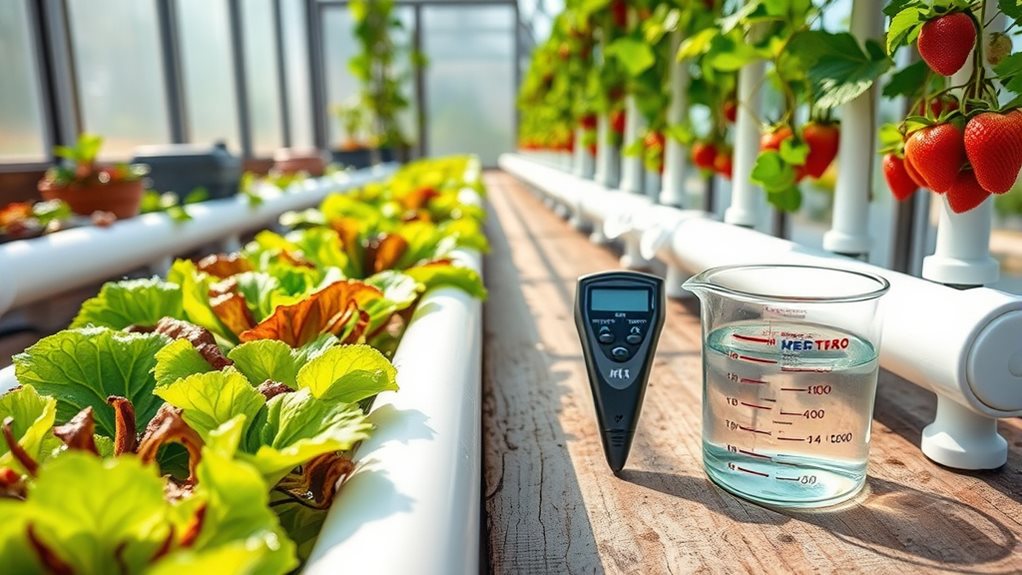
Have you ever wondered how plants can thrive without soil? Hydroponics is the answer—a modern growing method that uses nutrient-rich water solutions instead of traditional soil. You’ll find this technique incredibly sustainable, using up to 10 times less water than conventional farming while producing 2-4 times higher yields.
Why consider hydroponics for your gardening needs?
- Water efficiency—conserves this precious resource
- Space optimization—grow more in smaller areas
- Year-round production—regardless of outdoor weather
- Fewer pests and diseases—controlled environment means fewer problems
- Faster growth rates—plants receive nutrients directly
The system gives you precise control over temperature, light, and nutrients, creating ideal growing conditions. Unlike loamy soil, which is considered ideal for traditional gardening due to its balanced composition and moisture retention properties, hydroponic systems deliver nutrients directly to plant roots. Hydroponics completely eliminates concerns about soil degradation that plague traditional agriculture. While there’s an initial investment, the long-term benefits of reduced resource use and increased production make hydroponics worth exploring.
The Science Behind Plant Growth in Water-Based Systems
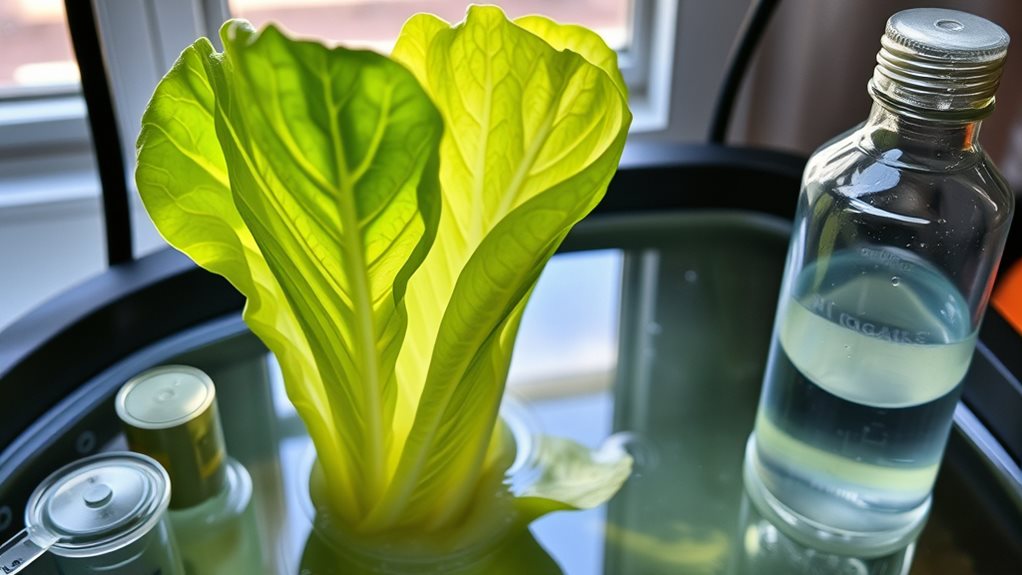
The fascinating world of hydroponics operates on remarkable scientific principles that make soil-free growing possible. Your plants’ roots adapt specifically to water environments, developing more surface area to maximize nutrient absorption without soil’s mechanical resistance.
When you set up a hydroponic system, you’re creating a controlled environment where plants can thrive through:
- Direct nutrient delivery – Plants receive precisely balanced nutrients directly to their roots
- Optimized root environment – No soil-borne diseases or pests to interfere with growth
- Enhanced photosynthesis – Controlled light and CO2 levels improve energy production
- Perfect pH balance – You’ll maintain ideal pH levels for maximum nutrient uptake
This scientific approach explains why your hydroponic plants typically grow faster, stay healthier, and produce higher quality crops than their soil-grown counterparts. The physics of your system will use hydrostatic pressure to efficiently circulate nutrient solutions and oxygen to plant roots. Unlike traditional composting that requires balancing green and brown materials, hydroponic systems focus entirely on water-soluble nutrients for plant growth.
Types of Hydroponic Systems for Beginners
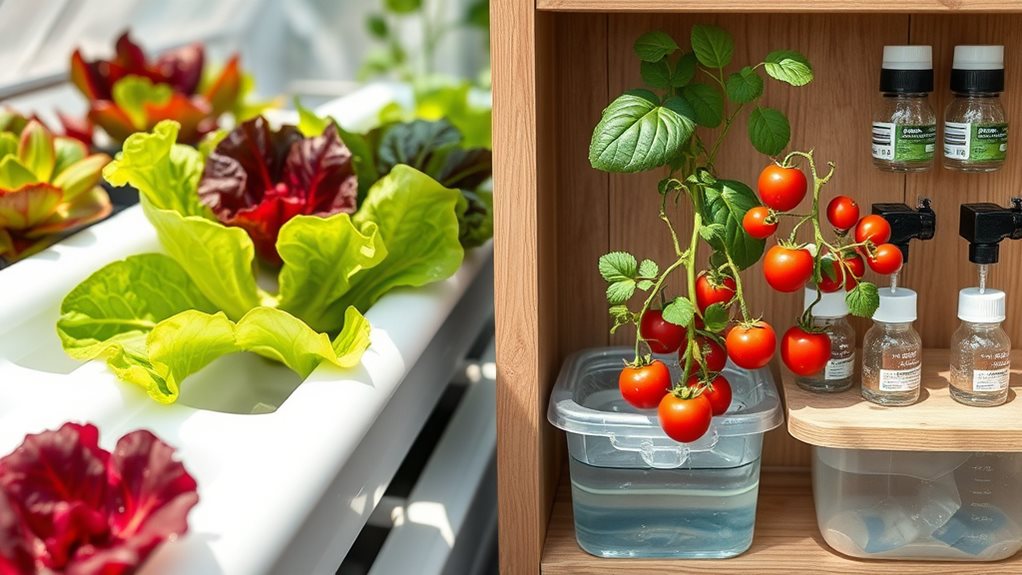
When you’re starting your hydroponic journey, choosing the right system can feel overwhelming, but understanding your options will make this decision much simpler. Let’s explore the most beginner-friendly setups.
The Wick System offers the easiest entry point, requiring no electricity or pumps—just a simple wick drawing nutrients to your plants. For slightly more engagement, try Deep Water Culture (DWC), where roots dangle directly in oxygenated nutrient solution.
If you’re comfortable with basic timers, consider an Ebb and Flow system that floods and drains your growing bed periodically. Nutrient Film Technique (NFT) works wonderfully for lettuce and herbs but needs careful monitoring. For precise water delivery, a Drip System provides controlled nutrition directly to each plant’s base. Much like how the Ancient Gardener in Disney Dreamlight Valley automates plant watering, modern hydroponic systems can be set up to deliver nutrients on a regular schedule.
Another excellent option for newcomers is the Kratky Method, which requires no water pumps and maintains an air gap between the water and plant bottom as the solution level naturally drops.
Choose based on your available space, maintenance preferences, and the plants you’ll grow.
Essential Equipment for Your First Hydroponic Setup
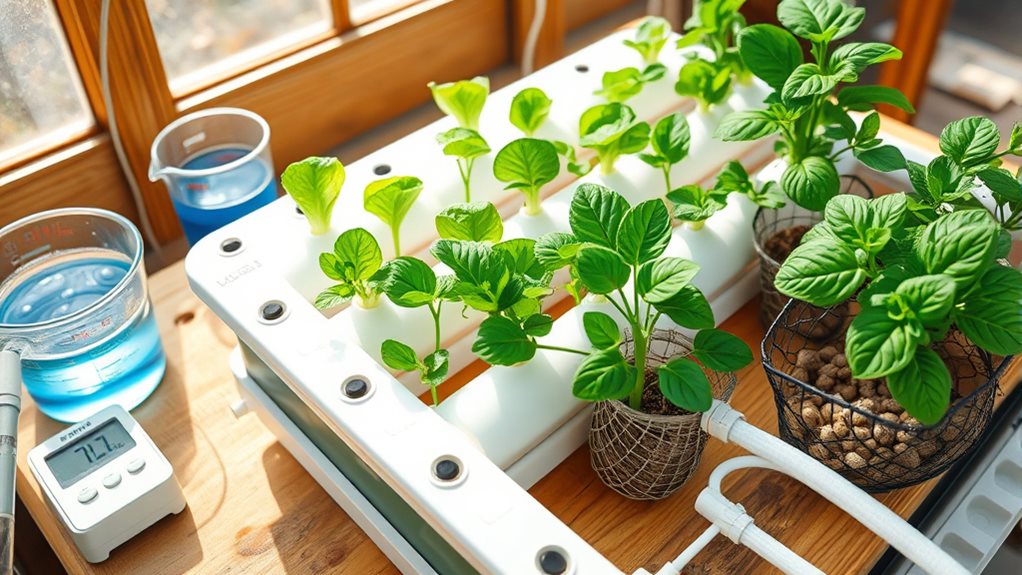
Building your first hydroponic system requires several key components that work together to create an excellent growing environment. Every successful setup needs proper lighting, water management, and environmental controls to help your plants thrive without soil. Just as traditional gardeners need ergonomic tools for comfort during long gardening sessions, hydroponic growers benefit from well-designed equipment.
Start with these four essentials:
- Lighting system – Choose LED grow lights that provide both blue light for growth and red light for flowering and fruiting
- Water reservoir with nutrients – Use a container that holds your nutrient solution and add an air pump with stone to keep water oxygenated
- Growing medium and containers – Select rockwool, clay pellets, or hemp in net pots to support your plants
- Monitoring tools – Invest in a pH testing kit and EC/TDS meter to maintain proper nutrient levels
For beginners looking to minimize initial challenges, a Deep Water Culture system provides a forgiving setup that’s easy to maintain while you learn the basics of hydroponic gardening.
Understanding Nutrient Solutions and Water Quality
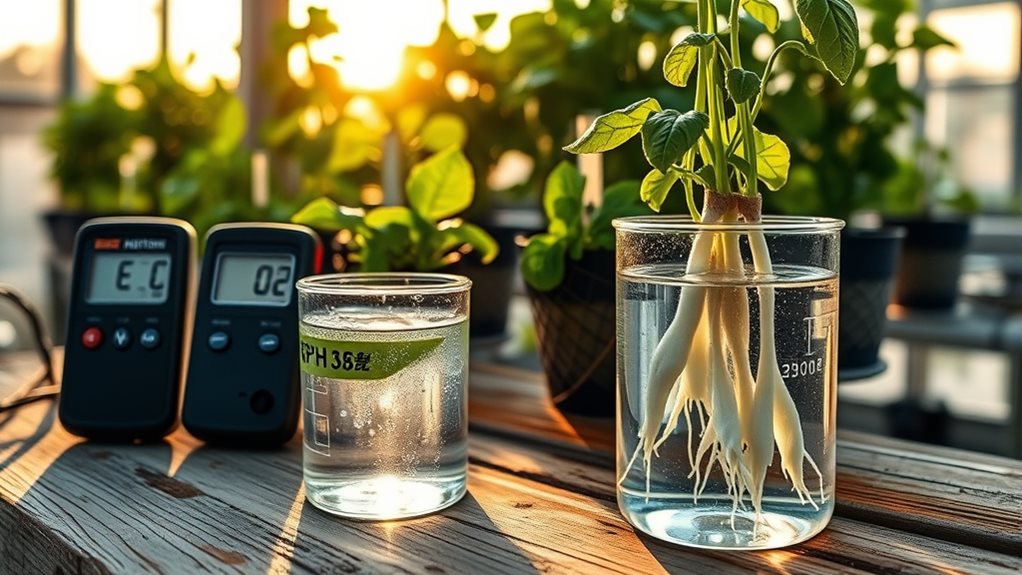
Successful hydroponic growing depends on properly balanced nutrient solutions, which serve as the lifeline for your plants in a soilless environment. Your plants need 17 essential elements to thrive, divided into macronutrients (N, P, K, Ca, Mg, S) and micronutrients (Fe, Mn, Cu, Zn, etc.). When selecting your nutrient management approach, consider whether to use fertilizer programs or nutrient solution recipes based on your specific needs and experience level. Unlike soil-based gardening that might use peat moss for moisture retention, hydroponics delivers water and nutrients directly to plant roots.
Key Nutrient Requirements:
- Nitrogen (150 ppm): Supports leaf and stem growth
- Potassium (210 ppm): Regulates water uptake and improves fruit quality
- Calcium (90 ppm): Strengthens cell walls
- Iron (1 ppm): Critical for chlorophyll synthesis
Water Quality Essentials:
- Maintain pH between 5.0-6.5 for ideal nutrient absorption
- Monitor electrical conductivity (EC) to guarantee proper nutrient concentration
- Use clean, contaminant-free water
- Test regularly and adjust as needed
Selecting the Right Plants for Hydroponic Success
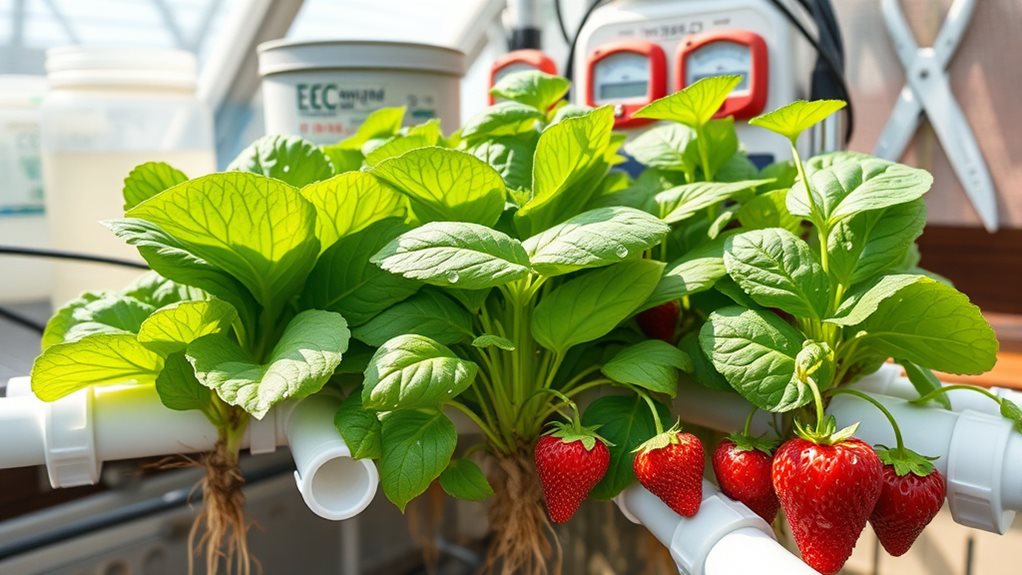
Not all plants thrive equally in hydroponic systems, which is why choosing suitable varieties becomes a critical first step for any successful grow operation. You’ll find that leafy greens and herbs typically yield the best results for beginners, while fruiting plants require more attention to lighting and pollination.
Plant selection makes or breaks your hydroponic garden—choose leafy greens for beginner success, save fruiting varieties for later.
When selecting your first hydroponic crops, consider these factors:
- Growth rate – Fast-growing plants like lettuce and basil provide quicker satisfaction
- Space requirements – Compact varieties conserve valuable system space
- Nutrient needs – Some plants require specific nutrient formulations
- Harvest potential – Plants that allow continuous harvesting, such as herbs and chard, offer extended value
Most hydroponic vegetables and herbs perform best in a pH range 6.0-6.5 environment, which supports optimal nutrient absorption and healthy growth.
For year-round production, focus on lettuce, herbs, and bok choy, which adapt well to indoor conditions with consistent lighting and temperature. Unlike traditional gardening, hydroponic systems don’t require a sunny location with well-draining soil, making them ideal for urban environments with limited outdoor space.
Common Challenges and Troubleshooting Tips
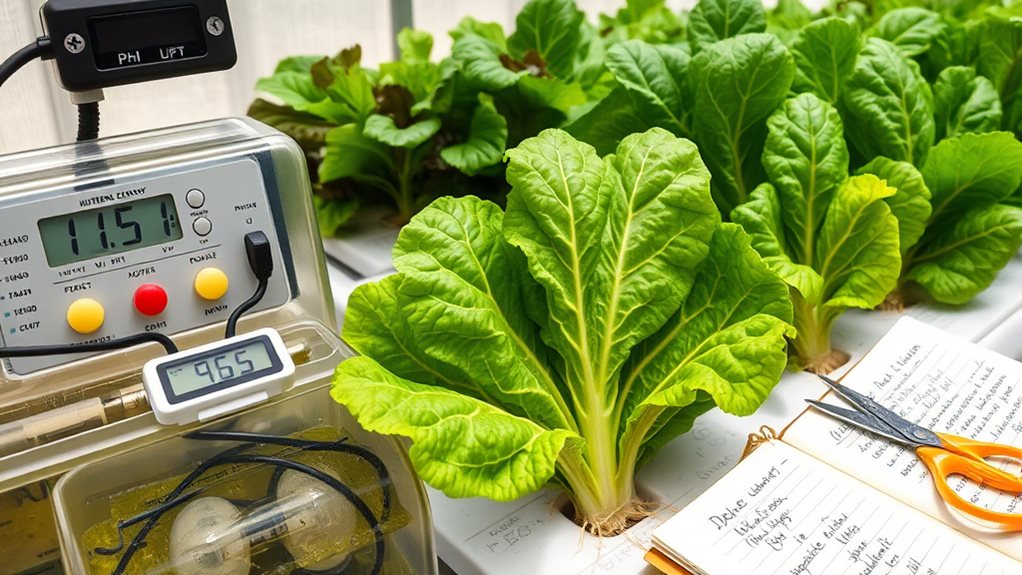
Five common challenges await even the most careful hydroponic gardener, but don’t worry—they’re all manageable with proper knowledge and intervention.
Nutrient Management
- Maintain pH between 5.5-6.5 for ideal nutrient uptake
- Monitor regularly and adjust with pH solutions
- Change nutrient solutions frequently to prevent salt buildup
System Maintenance
- Prevent clogging by flushing tubes with warm water
- Consider heavier growing mediums like expanded clay
- Clean reservoirs and tubing routinely
- Using garden forks for aeration can help when transitioning plants from hydroponics to soil.
Root Health
- Avoid overwatering and maintain good oxygenation
- Regulate water temperature to prevent root rot
- Ensure suitable airflow around roots
- Healthy roots should appear pearly white and any brown, slimy roots indicate potential disease.
Algae Control
- Block light from reaching nutrient solution
- Paint reservoirs black or use opaque materials
- Clean system components during nutrient changes
Maximizing Yields Through Environmental Control
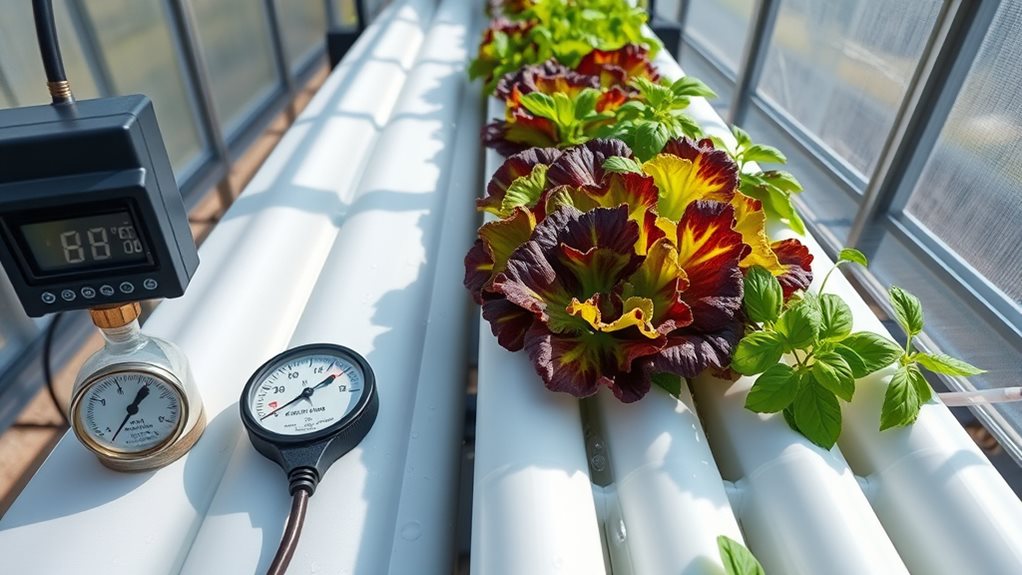
While troubleshooting helps you overcome challenges, mastering environmental control takes your hydroponic garden to new productivity heights. Your plants thrive when you maintain precise conditions, leading to bigger harvests and healthier growth.
To maximize your hydroponic yields, focus on these critical factors:
- Keep temperatures between 65°F-75°F, adjusting for specific plant needs with automation tools when possible
- Maintain humidity levels at 40%-60% using dehumidifiers or humidifiers to prevent disease
- Enhance photosynthesis with CO2 levels between 1,000-2,000 ppm, well above normal air concentration
- Install proper LED lighting that provides the specific spectrum your plants need, along with good air circulation
With consistent environmental control, you’ll enjoy year-round production and considerably reduced pesticide needs, making your system more efficient and productive. Having quality hand pruners nearby will help you maintain plant health by removing dead or diseased foliage that could impact your system. Monitoring and adjusting your nutrient solution’s pH and EC is essential for ensuring plants receive proper nutrition throughout their growth cycle.
Cost Analysis: Initial Investment vs. Long-Term Benefits
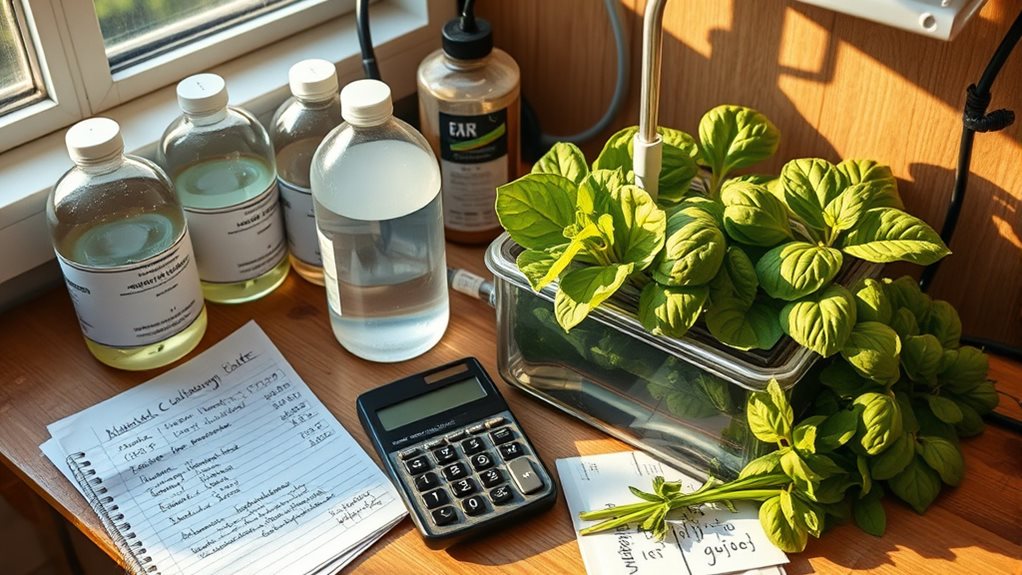
The journey into hydroponics begins with substantial upfront costs that often make newcomers hesitate before diving in. Your initial investment typically ranges from $103,000 to $280,000 for commercial operations, covering equipment, facility setup, staffing, and legal requirements.
However, these costs need to be weighed against considerable long-term benefits. You’ll use up to 90% less water than traditional farming, greatly increase your yield per square meter, and enjoy year-round production regardless of outdoor conditions. These advantages translate into a stronger ROI over time. For optimal results, ensure regular monitoring of pH and nutrients throughout your growing cycles. As with efficient composting solutions like the Hotbin Mk. 2, temperature monitoring is crucial for maximizing productivity in controlled environments.
Consider starting small if you’re budget-conscious. Small-scale systems can begin at just $2,500, while government subsidies may help offset expenses. Remember to factor in ongoing energy costs, which will impact your overall profitability.
Scaling Up: From Windowsill to Productive Garden

Once you’ve mastered a small windowsill setup, expanding your hydroponic garden becomes an exciting next step in your growing journey. Your scale-up strategy will depend on available space, budget, and growing goals, but the basic principles remain the same.
Consider these proven scaling approaches:
- Start with modular systems that allow gradual expansion without replacing your entire setup
- Invest in automation (timers, pumps, and monitors) to reduce daily maintenance as your garden grows
- Choose a primary growing method like NFT or DWC that suits your space and preferred crops
- Implement a consistent nutrient management routine with regular testing and adjustments
Vertical integration of your growing system can yield a dramatic land use reduction of up to 90-99% compared to traditional farming methods.
For those looking to achieve faster results with minimal effort, systems like the AeroGarden Bounty can grow plants up to five times faster than soil-based methods while requiring no outdoor sunlight.
Frequently Asked Questions
Can Hydroponic Systems Be Used for Organic Certification?
Yes, your hydroponic system can qualify for organic certification. The USDA allows hydroponic operations to be certified organic if they meet all organic standards, except soil fertility requirements.
You’ll need to:
- Use only approved organic inputs for your nutrient solution
- Work with a USDA-accredited certifier
- Follow all other organic regulations
Despite ongoing debates about soil-based requirements, courts have upheld hydroponics’ eligibility for organic status.
How Do Hydroponic Growth Rates Compare to Traditional Soil Methods?
Your hydroponic plants will grow 40-50% faster than their soil counterparts. You’ll also enjoy 20-25% higher yields in the same space. This efficiency comes from direct nutrient delivery to plant roots, eliminating the energy plants spend searching for nutrients in soil.
Water efficiency is another bonus, as your hydroponic system will use 90% less water than traditional methods. The precise control over growing conditions like pH and temperature further contributes to this accelerated growth.
Is Hydroponics Suitable for Medicinal Plants and Herbs?
Yes, hydroponics is excellent for medicinal plants and herbs! You’ll find that hydroponic systems provide precise nutrient control, which often enhances the medicinal compounds in your herbs.
You can grow chamomile, echinacea, thyme, and many other therapeutic plants year-round without pesticides. Your hydroponic herbs will typically contain higher concentrations of beneficial compounds than soil-grown alternatives, making them ideal for medicinal purposes.
The clean, controlled environment also guarantees consistent quality in your medicinal harvest.
What Career Opportunities Exist in Commercial Hydroponic Farming?
You’ll find diverse careers in commercial hydroponics, including:
- Grower positions where you’ll manage plant care and growth conditions
- Technical roles where you’ll maintain and repair systems
- Research positions where you’ll experiment with improving techniques
- Operations jobs where you’ll oversee daily farm activities
With salaries ranging from $40,000 to $95,000, you can start with a high school diploma for entry-level positions. Technical training or agricultural degrees will help you advance to specialized roles.
How Does Hydroponic Produce Taste Compared to Soil-Grown Equivalents?
You’ll find that hydroponic produce often tastes fresher and sweeter than soil-grown equivalents. This is because you’re controlling the exact nutrients plants receive, which can enhance flavor profiles.
Many people notice hydroponic produce has consistent taste year-round, unlike seasonal variations in soil-grown foods. The quick farm-to-table timeline of local hydroponic farms also preserves flavors that might diminish during longer shipping times for conventional produce.
Conclusion
You’re now equipped with the essentials of soil-free gardening! Remember, hydroponics isn’t just a hobby, it’s a sustainable way to grow more food in less space. Start small, monitor your plants regularly, and adjust as you learn. Don’t worry about making mistakes, as they’re valuable learning opportunities. With patience and practice, you’ll soon enjoy fresh, nutrient-rich harvests year-round, regardless of your available space or growing conditions.

